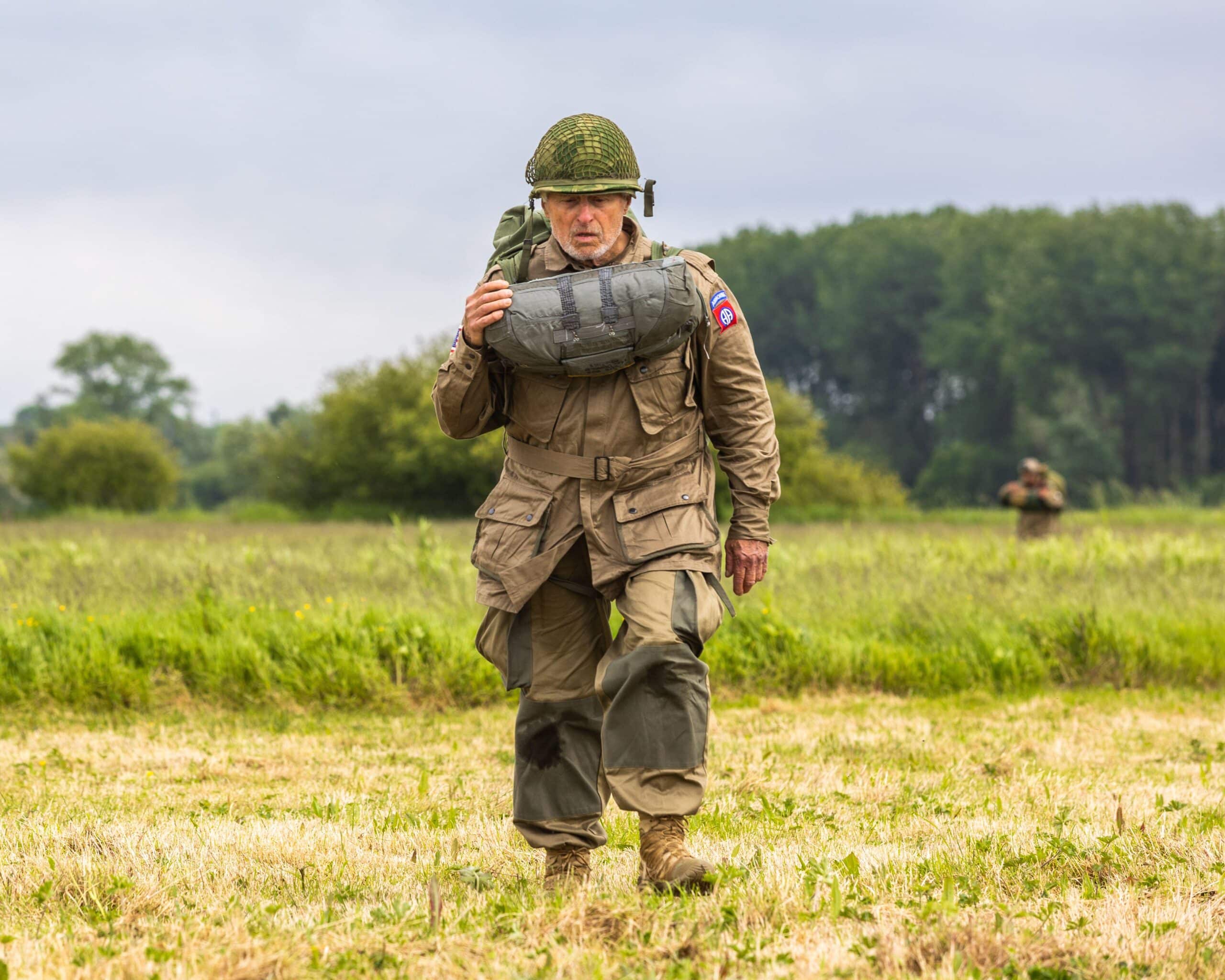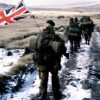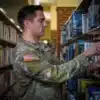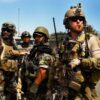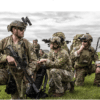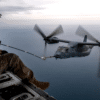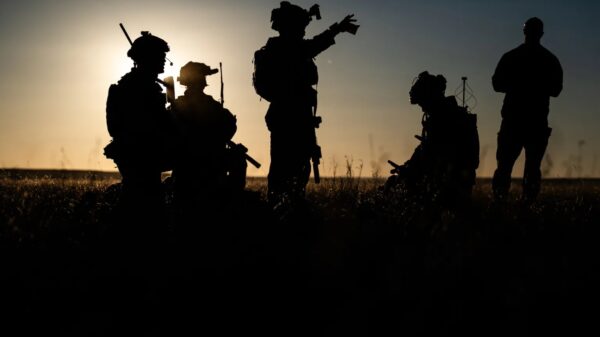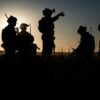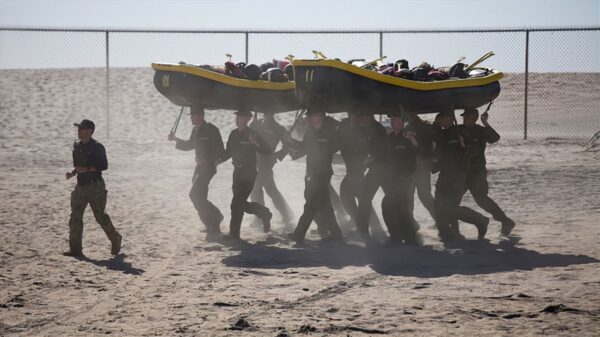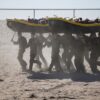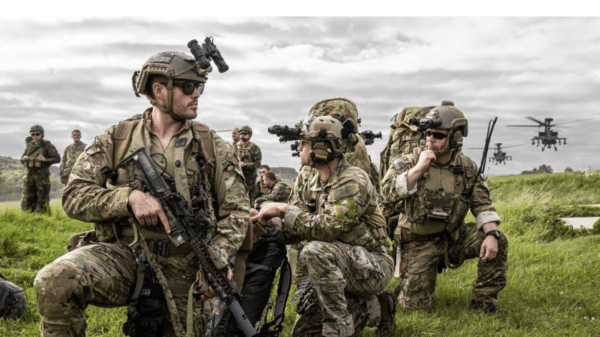J. Paul de B. Taillon, Samuel Associates, Ottawa, Canada
ABSTRACT
This article provides an overview of the concept, development, deployment, and validation of the multinational Jedburgh concept that was conceived by Major General Sir Colin Gubbins, head of the Special Operations Executive (SOE). This concept consisted of inserting three-man teams into France who were specifically recruited, trained, and designed to assist resistance forces in the conduct of unconventional warfare in the wake of D-Day 6 June 1944. These teams provided communications, coordinated aerial resupply, equipment, and helped to, if needed, provide direction for the French resistance known as the Maquis. The success of these teams and their operations laid the foundation for the U.S. Army Special Forces, as well as provided important insights as to the criticality of incorporating language and culture within future similarly tasked military teams assisting and supporting irregular/unconventional operations.
In no previous war, and in no other theater during this war, have resistance forces been so closely harnessed to the main military effort.
– General Dwight D. Eisenhower (1945)
When Great Britain entered the war on 3 September 1939, and the United States later 7 December 1941, both militaries were designed for conventional conflict and focused essentially on attritional warfare. Interestingly, both countries had substantial experience in what was respectively described as imperial policing and small wars. For the professional soldier prior to World War II, the type of operations that would theoretically take place in the enemy’s rear area now formally recognized as unconventional warfare (UW), was neither a focus of mainstream professional military thought nor a concept demanding any formal study.
Notwithstanding, these described “behind enemy lines” UW operations are presently captured under the umbrella of the term irregular warfare (IW), which embraces a spectrum of activities to include counterterrorism (CT), Foreign Internal Defense (FID), counterinsurgency (COIN) and Stability Operations (SO). There were a number of proponents and practitioners who conducted UW during the world wars of the twentieth century.[1] The UW experience demonstrated the substantial advantages that these operations offered particularly in the forced dispersal of enemy troops, the requirement to secure and effectively protect the population centers, vital governmental, economic and military installations, as well as the lines of communication amongst others within the target country. For some military professionals, twentieth century UW campaigns highlighted the most effective force structure, as they are considered to be “relational-manoeuvring forces.” These effective guerrilla organizations were adept at ascertaining the enemy’s weaknesses or vulnerabilities and then adjusting their internal composition, enabling them to engage and attrit the enemy effectively.[2]
Britain’s Great War experience in the employment of the Arab revolt to assist conventional military operations during their Middle East campaign (1916-1918), under the auspices of Lieutenant Colonel T. E. Lawrence, whose guerrilla army of Arab tribesmen created havoc throughout Ottoman occupied territory in Arabia, was notable. As well, the Imperial German campaigns in East Africa (1914-1918), General Paul von Lettow-Vorbeck and his force of 14,000 Askaris held in check a military force of 300,000 consisting of Indian, British, Belgian, and Portuguese soldiers who were much-needed on other fronts set a standard not before realized in UW. Both officers epitomized the economy of effort in their respective application of guerrilla strategy. The UW concept was further explored and applied in World War II through a panoply of Allied Special Forces (SF) and special operations organizations developed to oversee UW in the form of raising and facilitating guerrilla organizations and to support and coordinate their operations.
This article focuses on the concept of supporting resistance groups, in this case the French Maquis, by multinational Jedburgh teams consisting of British, American, and French personnel who were to be deployed in the wake of D-Day on 6 June 1944 within the German rear echelon. The terms guerilla, resistance, resistance fighters, paramilitary, and Maquis will be used interchangeably.
Background
By mid-March 1943, Supreme Headquarters Allied Expeditionary Force, under the command of General Dwight D. Eisenhower, and its joint staff commenced planning for the strategic inevitability of an invasion of the European continent. At this time both, the United States and Russia were heavily involved in this global conflict and an invasion of occupied Europe was politically and militarily envisioned and being forcefully pressed. Understandably, the location of the invasion and the preparation for subsequent follow-on operations were in the nascent planning stages as it would take time to formulate, coordinate, and execute the myriad of preparations necessary for an opposed landing in Europe.
Predicated upon ongoing intelligence and low-level guerrilla operations being conducted from 1941 by the British in Europe, there were strong indications—indeed optimism—that an Allied force would encounter a friendly population actively interested in supporting their liberators.
The Assessment Challenge
Planners realized that these emerging resistance organizations were already providing smatterings of intelligence, conducting sabotage and small order paramilitary activities in some German occupied countries mainly under the auspices of the British clandestine services, particularly the Special Intelligence Service (SIS), also known as MI6 and the newly created Special Operations Executive (SOE). The question arose: If properly organized, equipped, and trained, could these resistance elements effectively assist Allied efforts in the post-invasion campaign?
As with any resistance movement, certain challenges would have to be recognized and addressed to ensure that the resistance could be assisted and equipped to undertake a spectrum of operational initiatives in support of the Allied forces during the liberation of the continent.
One of the initial questions to be addressed was what assistance would the French resistance, known as the Maquis, require to undertake effective guerrilla operations against their German occupiers? Another critical issue was how could the Allies employ the Maquis to the best advantage? Should these resistance organizations be restricted to undertaking sabotage operations, directing local populations away from danger areas, or should they be assigned to assist the civil authority or was there a more important and effective way to participate in the Allied plan? Another perplexing concern for the staff was: Could these resistance groups pose an additional planning and organizational dilemma in an already complex multidimensional military operation? If so, should they be directed to abstain from activities, thereby keeping them completely out of the fight?[3] These questions and many others had to be surfaced and examined by the Allied senior staff, as well as the leadership and planners of the British SOE and the American counterparts of the Office of Strategic Services (OSS).
Gubbins the Visionary
Major General Colin Gubbins was a well-regarded British regular officer and avid student of UW. He was one to promulgate these “unconventional ideas” about the potential application of resistance forces where he soundly and persuasively argued for the exploration of the theory of creating military teams assigned specifically to liaise, assist, coordinate, and, if necessary, direct indigenous guerrilla forces.
Gubbins was specifically selected for the position as head of the SOE, predicated on his experience with UW in the form of terrorism and guerrilla activity in Ireland and Russia, as well as his intellectual curiosity and broad mindedness to ponder new ideas and concepts. He drew from the experiences of the Second Anglo-Boer war, combating highly mobile and effective Boer guerrillas, the exploits of Lieutenant Colonel T. E. Lawrence[4] and the highly successful German guerrilla campaign in East Africa led by General Paul von Lettow-Vorbeck. [5]
Gubbins noted the dearth of study of UW, or as it was described at that time IW, which had an impact upon the development of the SOE:
“To anyone who has studied the Russian Revolution or, nearer to home, the Sinn Fein insurrection, or the Palestine rising, or the Spanish Civil War, the crippling effect of subversive and para-military warfare on regular forces was obvious. Yet these campaigns, or nationalist risings, were not studied at any of the higher colleges of war; they were irregular and not really deemed worthy of serious attention. This was the root of SOE problems.”[6]
Through his wide-ranging and intensive study, he amassed many of the basic principles of UW that embraced the importance of sound and effective organization, the importance of situational awareness, the criticality of intelligence, the recognition of local operational requirements pertaining to language and culture,[7] and the necessity of effective leadership. His intellectual independence departed from some of the students of IW/UW, as he sought a coherent strategic vision that would see the integration of resistance efforts to facilitate and support aims and objectives of a conventional military campaign.[8] This integration and concentration of effort, as well as appreciating the economy of force of UW underlines important aspects represented in the principles of war, amongst others.[9] Gubbins believed that all necessary means within his purview should be directed and massed for a concentrated effort in support of maximizing the opportunities for success for the Allied liberation.[10]
To achieve this, the French resistance would have to be coordinated in sequence with the Allied ground campaign. The quandary for the conventional and special operations planners was how the Allies could employ such guerrilla forces to the best advantage during the post-invasion campaign.
Supporting the Maquis
The SOE had, since its creation on 22 July 1940 by the Minister of Economic Warfare Hugh Dalton and supported by British Prime Minister Winston Churchill who famously said, “set Europe ablaze,” built up a network of Allied contacts and operators while conducting intelligence gathering and sabotage activities while managing a variety of low-level psychological operations within France and parts of occupied Europe.
The question was: Should the SOE network and operators continue with these tasks or should they embark upon the development of expanding links with the Maquis, who were operating mainly in the French countryside? Should the liberation of the continent begin, the expectation was that the resistance, if properly prepared and equipped, might successfully rise up. Their objectives would be to attack German communications and logistics hubs and interdict and attrit their ground units which would inevitably be hurried to the invasion site with the objective to thwart the amphibious landings on water’s edge, thereby nullifying the invasion and any possibility of subsequent follow-on operations. Understandably, the former strategy already in operation would have a high nuisance value in the practice of mining roads, bridges, and power stations but realistically such operational initiatives were seen as providing little tactical impact on the military outcome. Another conundrum for planners was the apprehension that large formations of untrained, ill-disciplined resistance fighters would be expected, indeed urged, to engage experienced German military units. Understanding that the resistance fighters would have the advantage of local knowledge and the likely succor of the resident population, another issue arose. It was the view that French resistance fighters without support and guidance would quickly be engaged and eradicated by the more tactically practiced German units that had the advantages in armored vehicles, artillery, mobile reserves, and air support. The conflict confronting Allied planners was essentially the choice of “pinpricks” in the form of sabotage, minor interdiction activities, psychological warfare upon the Germans, but also the potential of dislocating local French support due to the likelihood of indiscriminate massacres[11] that would likely occur as such punishment be a by-product of Maquis activity. The other option was harnessing the resistance as a coordinated support element to assist the Allied conventional forces in their ground campaign.
Gubbins and his staff recognized the advantages that would accrue should the Maquis orchestrate the destruction of German telephonic communications thereby forcing the Germans to revert to radios. This would enable their signals to be intercepted and jammed by the Allies. Meanwhile, the well-orchestrated destruction of German fuel and logistics stocks, as well as the delay, interdiction, and attrition of supply convoys and vitally needed reinforcements would have a material impact upon the battlefield, as well as inflicting serious psychological effect on the German soldiery. Such assignments were considered a priority for the Maquis.
There was, however, a subtle yet important complication that haunted this plan, predicated on the domestic frictions of French politics, especially between the resistance elements who supported General Charles de Gaulle’s Free French[12] or the Vichy regime of Marshal Philippe Petain[13] and those who were inspired Communists. It was recognized that political obstacles would have to be handled gingerly by those assigned to work with these respective resistance groups; appreciating the inevitable invasion of the continent and the importance of making sure that the Maquis would be capable of partaking effectively in such a mission set.
Gubbins penned a note to SOE’s Security Section outlining in brief the concept and requesting a cryptonym:
A project is under consideration for the dropping behind of enemy lines, in co-operation with an Allied invasion of the Continent, of small parties of officers and men to raise and arm the civilian population to carry out guerrilla activities against the enemy’s lines of communication. These men are to be recruited and trained by SOE. It is requested that ‘Jumpers’ or some other appropriate code name be allotted to this (sic) personnel.[14]
Soon after this request, the SOE’s Security Section assigned the codename JEDBURGH to this SOE initiative.
The Jedburgh Concept is Put to the Test
As the Jedburgh concept paper was being disseminated and navigated through the British, the Commander in Chief Home Forces, General Sir Bernard Paget was orchestrating a comprehensive and demanding exercise codenamed Spartan. Taking place in the early spring of 1943, this exercise comprising of some 250,000 men and 72,000 vehicles would not only test the capabilities of Allied ground forces but would also be the first field test on the efficacy of the embryonic Jedburgh concept.
This was an important conventional exercise as it was formulated to assess the ability of an Allied invasion force confronting experienced German defenders who were in well-prepared defensive positions. After four years of occupation, the German troops intimately knew the terrain and could expect the “possible reinforcement” by armored and mechanized panzer grenadier reinforcements from their reserves.
When General Headquarters Home Forces (GHQHF) command and staff requested the SOE to provide twelve Jedburgh teams for Spartan, it provided Gubbins, his staff, and official observers an ideal opportunity to fully evaluate the Jedburgh concept. It would further enable them to ascertain what missions would be appropriate for these teams, to magnify their tactical and operational level impact when inserted into the opposing force’s (OPFOR) exposed echelon.
Adding to the complexity, at this time there were no Jedburgh teams in existence and no associated command, control, and communications elements available for deployment. To fulfil the headquarters prerequisite for this now critical confirmation exercise, a hastily organized staff was summoned, consisting of SOE staff officers supported by instructors and wireless operators, many of whom were assigned for exercise purposes as Jedburgh team operators. This rapid assembly group enabled the provision of a command and liaison team for the 1st Canadian Army Headquarters (1CAHQ) as well as generating eleven 3-man operational teams assigned for the exercise under the codename of BOYKINS. Participating as resistance fighters were 400 soldiers from the Royal Welch Fusiliers who were keen to participate in their new role.
To assist in the deployment of the Jedburgh teams, SOE staff officers led by Lieutenant Colonel Peter Wilkinson, were charged with drafting a spectrum of real and notional incidents and activities to be incorporated into Spartan. It must be acknowledged that the Jedburgh teams and supporting elements at this time had been “cobbled together” and some SOE staff elements had never had the advantage of operating within higher formation headquarters.
From a command and SOE point of view, this was a tremendous act of faith which provided the opportunity for the application of a new and untested concept within a major exercise. In a more peripheral way, it indicates how special operation visionaries, operators, and supporters are, arguably in many cases, strategic change agents.[15]
One of the key players in Spartan was the Canadian Army General Andrew McNaughton[16] who was willing to experiment and embrace new and untried tactical concepts.
The exercise comprised of an advance to contact, as well as a scenario devoted to the conduct of mobile defense against an Allied army group which included a breakout phase. Of note, both the Allied and OPFOR forces were not permitted any aerial or ground reconnaissance beyond the forward edge of the battle area; hence both Allied and OPFOR commanders had to plan and conduct their respective operations with no detailed topographic, terrain information available other than what could be gleaned from the maps provided to them.
McNaughton was assigned the command of the Allied Second Army comprising of 1st and 2nd Canadian including 12 Corps, consisting of one armored brigade and six divisions. Also allocated to McNaughton were 11 Jedburgh teams. McNaughton, a former artillery officer with a strong scientific and engineering bent, was an advocate and his openness to the Jedburgh concept aided in ensuring a fair test of this new and unproven concept. In tandem, GHQHF supported the employment of espionage and counterintelligence activities in the exercise, as well as the incorporation of a guerrilla force that would have to be addressed by the OPFOR commander and his subordinates. Throughout the exercise, Gubbins’ staff officer Lieutenant Colonel Peter Wilkinson, kept 1CAHQ commander McNaughton and his staff fully briefed as to Jedburgh exploits and their aid to the resistance.
For the purpose of the Spartan exercise, the teams were assumed to have been inserted prior to and in the wake of the invasion. Throughout the course of the field test, the assigned Jedburgh teams monitored road activity, reporting the volume and nature of traffic and, when opportune, conducted interdiction missions. The teams were also tasked with demolishing bridges and installations, planning and coordinating attacks upon demolition guards, conducting direct action missions against headquarters and communication centres, as well as the interdiction and destruction of supply convoys. The targeting of OPFOR personnel assigned to traffic control was also within their exercise remit.
One of the objectives was to establish the survivability of the Jedburgh teams and their designated resistance fighters who would be operating with little support behind enemy lines. It was assumed that the resistance would continually be challenged by an aggressive, robust, and effective German signals and intelligence[17] capability specifically focused on locating and severing Jedburgh communications.
Throughout the duration of exercise Spartan, the resistance elements and Jedburgh personnel were continually gauged on their tactical value in interdicting the OPFOR while, concomitantly ascertaining how these teams could best be employed to maximum tactical effectiveness. The exercise and SOE command element needed to ascertain timing i.e., when best to deploy the teams to utmost effect upon the lines of communication and, importantly, ascertain the Jedburgh operator’s longevity against an occupation force that embodied a highly effective intelligence, counterintelligence, and radio interception capability combined with an aggressive battle-hardened enemy in pursuit.
During exercise Spartan, McNaughton and his Chief of Staff Guy Simmonds, a favorite of Field Marshal Bernard Montgomery, fully appreciated the potential of the Jedburgh concept.[18] The teams were assessed as having successfully attacked, disrupted, and destroyed a number of headquarters, having demolished numerous supply dumps, compounded with the destruction of several important bridges and the obliteration of numerous enemy vehicles and other important OPFOR installations. As Colin Gubbins biographer put it: “The concept was validated at the Spartan wargames of March 1943, which convinced the British Army that SOE could, with limited expenditure, stimulate resistance and provide reliable support to an advancing conventional force.”[19] For Gubbins, Wilkinson and his staff, the Jedburgh concept was a proven success.
Lessons of Spartan
The post-operational report brought to the surface several important observations and conclusions[20] that were extracted from the deployment of the Jedburgh teams.
Firstly, it became quite clear that these teams should be assigned a specific area of operations, as well as the precise tasks that would assist the Allied ground force operations. Moreover, these teams would have to be inserted near the respective operational area. Furthermore, timing was recognized as a significant factor, as the time span between the Army commander designating and assigning Jedburgh missions had to account for the respective initiation, planning, and execution phases of a task which required a 72-hour mission cycle. This was predicated upon the time requirements of preparing the personnel to be inserted, contact, and liaise with the local Maquis organization, set up communications and request supply drops of weapons, ammunition, and other stores, if necessary. This cycle would include the conduct of ground/target reconnaissance that would enable the planning, briefing of resistance members, rehearsals, and finally mission execution.
From the staff point of view, it was recognized that the immediate rear area of the German lines would be well monitored and patrolled by the occupation forces, hence the Jedburghs and the Maquis should operate deeper in the exposed flanks and rear echelon where there would be a smaller German presence. Another lesson drawn from Spartan was that commando and airborne forces could be employed to execute a coup de main mission if deemed necessary. It was the command perception that their fitness, training, discipline, and tactical prowess to work effectively under operational duress could augment and/or address missions of complexity beyond the capability of the Jedburgh teams and their associated resistance forces. Finally, the invasion planners argued for the preparation of a contingency plan for the evacuation of the Jedburghs should the Allied post-invasion campaign encounter serious difficulty or, in the worst-case scenario, face defeat. Thankfully such a plan was never required; nevertheless, it was prudent of the planners to be prepared for such a contingency and note it in the lessons learned.[21]
Team Selection and Training
The lessons drawn from Spartan formed the basis of a secret document that was promulgated on 6 April 1943 by the head of SOE’s Planning Section, Colonel M. W. Rowlandson. This document became the Jedburgh basic directive that was issued on 20 December 1943, formalizing the intention of producing 300 Jedburgh teams by 1 April 1944.[22] This number of teams was never realized, arguably due to time and dearth of qualified personnel with the requisite language and cultural skills, notwithstanding an intensive program of selection and operational training that commenced with the subsequent “marrying up” of 3-man Jedburgh teams drawn initially from within the SOE and OSS, and other select volunteers.
The primary selection understandably sought military personnel with recent combat experience who knew how to handle small arms[23] and were proficient in instructing others in weapons, basic demolitions, and tactics. In tandem, an important practicable requirement was that radio operators had to be exceptionally proficient in their signals trade. The Jedburgh teams had an additional imperative to incorporate one French-speaking teammate ensuring that at least one Jedburgh member could communicate in French to liaise, instruct, coordinate, train and, if necessary, direct Maquis members. Hence the ability to communicate effectively in the French language and for a lesser extent cultural understanding, was seen as mission critical. This requirement and others were clearly specified in the OSS Special Services Field Manual which states that:
SO agents and operatives are selected for their intelligence, courage, and natural resourcefulness in dealing with resistance groups. In addition (sic) they must have stamina to be able to live and move about undetected in their area of operations. Normally, they should be fluent in the local language and be a native of a nationality acceptable to the authorities and people of the area. [24]
Before the first teams were to be formed in mid-March 1944, the SOE/OSS were confronted with a serious challenge as there was a shortage of French-speaking personnel to be incorporated in the Jedburgh teams. Fortuitously, this gap was remedied due to the reinforcement from North Africa and the Middle East of 73 Free French officers. This timely and operationally critical addition added significantly in French language capability and cultural awareness, and improved the Jedburgh credibility once they deployed, as the Maquis would be now working hand-in-hand with their fellow countrymen.
One interesting peculiarity that was contrary to the disciplined mindset, so typical of conventional military organizations of the era, was the evaluation of personnel who would, as required, question authority and have no compunction in speaking up when necessary. It was assessed that this personality quirk or characteristic was a quality that would foster activities in line with the Jedburgh mission.[25]
Those interested in volunteering for the Jedburgh assignment commenced their journey with an extended and intensive interview with three psychiatrists focused on ascertaining the personality type and mental fitness for this specific UW mission. This was followed by preliminary training in Scotland consisting of physical hardening, demolitions, weapons, and tactics and by technical courses in Gloucestershire, Leicestershire, and Woking. This preparation continued until 3 February 1944 when Milton Hall became the main Jedburgh training facility. Radio operators continued their intensive wireless training and instruction, as well as a parachute course, and for those qualified, a para refresher that was run at Altrincham, Manchester. In the wake of the training, the graduates were given an arduous five-day field test exercise in Sussex under simulated combat situations.[26]
The final selection of Jedburgh personnel initially was made by Lieutenant Colonel Spooner, a British Army officer and first commandant of the Jedburgh training school. It is notable that attention was also paid to the opinions and preferences of the Jedburghs as to the selection of fellow teammates. It was assumed that enabling the operators to choose their teammates would facilitate and enhance harmony amongst and within the teams. [27]
The preparation for the Jedburgh missions continued unabated focusing upon “guerrilla warfare tactics and skills: demolitions, use of enemy weapons, map reading, night navigation, agent circuit operations, intelligence, sabotage, escape and evasion, counterespionage, ambushes, security, the use of couriers, and hand to hand combat”[28] in anticipation of their demanding assignment. A valuable insight comes from a base document entitled the “Jedburgh Tasks and Training Priorities” which bluntly identifies the training priorities of the Jedburghs and likely mission set.
Training Priority A
- Rail cutting
- Attacks on enemy road vehicles and transport parks.
- Misdirection and dislocation of road traffic.
- Delay and dislocation of panzer divisions.
Training Priority B
- Destruction of telecommunications.
- Liquidation of enemy commands and staffs.
- Interference with enemy’s logistics.
- Attacks on Luftwaffe.
Training Priority C
- Destruction of electric power facilities used for military purposes.
- Demolition of minor bridges, or major bridges already prepared for demolition by the enemy.
- Prevention demolitions by the enemy.
- Observation reporting of enemy positions, headquarters, military supply dumps, and installations.
Training Priority D
- Attacks on railway facilities such as roundhouses and turntables.
- Attacks on railway engines and rolling stock, without causing long-term damage.[29]
This training list clearly illustrates the expectations in the mission set four Jedburgh teams’ assignment.
Clandestine Services – Mission Coordination Issue
In the run-up to the invasion of Normandy on 6 June 1944, British intelligence and military leaders were confronted with a serious dilemma. The Secret Intelligence Service (MI6), and the SOE were challenged with how to work together effectively and concomitantly assist the upcoming invasion in France given their seemingly overlapping responsibilities and competing missions. The Jedburgh concept and mission were seen to be problematic by various MI6 bureaucrats and their operators, as well as within SOE itself, as their respective personnel were already engaged in operations in the field. To clarify and address these concerns, Gubbins promulgated the idea that satisfied the Allied objective of harnessing the French resistance while responding to the objections of those clandestine services already operating on the continent. Gubbins’ compromise ensured there was no confusion with ongoing MI6 and SOE missions already in place.
While MI6 focused on deriving intelligence from occupied Europe, the SOE had created a number of networks in the urban areas of France enabling them to provide logistical support to local resistance and undertake clandestine operations such as military, transport and industrial sabotage missions designed to annoy, frustrate and vex the German occupiers. An exploration of this mission set did not, however, embrace or reflect the type of mission undertaken by the Jedburgh missions during Spartan which demonstrated that this new concept was seen as an exceptional ‘economy of force’ operation while considered to be potentially valuable force multipliers.
To differentiate these missions from ongoing MI6/SOE clandestine operations, the personnel assigned were to be in military uniforms. These teams by necessity evolved to be a unique multinational force with an American, British (Commonwealth) or French member, with a trained wireless operator.
Gubbins soundly argued the components of this concept to obtain an appropriate undertaking for the Jedburghs – to seek out and liaise and support the Maquis who were conducting operations throughout the French countryside. The Jedburgh teams would be positioned to conduct liaison, undertake as necessary the supply and training of the French Maquis and the setup communications to Special Forces Headquarters (SFHQ) and facilitate, coordinate and if necessary direct Maquis operations. In short, to lay the groundwork for the day when the French resistance would surface and conduct a spectrum of military activities such as interdicting and severing lines of communication, delaying and destroying reinforcements and hamstringing German logistical support. Such activities, if well-orchestrated and aggressively pursued, would necessitate the German forces to disperse much-needed military personnel destined to reinforce the front, instead they would be assigned to rear area security.
Another more subtle yet effective aspect of conducting UW in the depth of the German rear, was the ability to impart a degree of fear, paranoia, and psychological dislocation amongst the German rank-and-file, promulgating the notion that no one was safe even in rear. This facet of psychological warfare has an important feature in the conduct of UW.
Change of Role
The Jedburgh concept was a dramatic shift for the SOE in tasking, tactics, organization, personnel, and operational design. This UW concept demanded the adoption of a much more overt (uniformed) and fulsome support role to an indigenous resistance movement than had been previously envisioned since its inception in 1940.[30]
Consistent with this, the teams were inserted well behind enemy lines, sometimes up to 40 miles, and with little combat power due to the small numbers within each team. Teams were provided with a variety of small arms for protection and demolitions to be distributed to facilitate the disruption of enemy lines of communication, which required little training on the part of the French Maquis.
The Jedburghs were able to maximize their tactical effectiveness through their ability to communicate with SFHQ to prompt weapon and supply drops to arm and sustain their Maquis comrades. This facility brought the realization and recognition that the Jedburgh teams were true force multipliers in the unconventional sense. Predicated upon their innate capabilities and the insignificant numbers of Jedburgh personnel, their operations were proven to be low cost in terms of the human resources invested and the supply of arms and ammunition provided, in comparison to the activities generated by the Maquis which was considered to be highly effective.
Thirteen Jedburgh teams were para inserted behind German lines post-invasion in June 1944, ten of them in Brittany, which General Eisenhower declared was a priority area for Allied operations, hence a priority for Jedburgh teams to support the resident Maquis. Another 70 teams were inserted between July and September, with the majority to the areas of the northeast and northwest of the Massif Central. This is the mountainous region of central France from where resistance units of the now named Free French Forces of the Interior (FFI) effectively harassed withdrawing German troops who were falling back from the Allied forces who invaded southern France towards the French German border. There were 286 Jedburgh operators consisting of 90 British (Commonwealth), 103 French, 83 Americans, 5 Belgian, and 5 Dutch who were infiltrated into France and then into Belgium and Holland between June and October 1944.[31]
The Jedburgh Teams are Brought into Play – OPERATION FRANCIS
Commencing the night of 5 June and 6 June 1944, Jedburgh teams began their respective deployments throughout occupied France, up to the German withdrawal in September 1944. To garner an insight as to the typical challenges that a Jedburgh team had to overcome during the post D-Day time period, this article shall highlight the activities of one Jedburgh team:
Operation Francis was inserted on the night of 9 July and 10 July 1944 with the designated area of operations being the Finistere region of Brittany, France.
The team was commanded by 33-year-old Major Colin Ogden-Smith,[32] who had previously served in the SOE’s Small Scale Raiding Force (SSRF). Married with a small child, prior to the War he had managed his family’s business and subsequently joined the British Army, gaining combat experience during his service with 7 Commando. By the spring of 1943, the SSRF was stood down and he was assigned to the SOE in North Africa; by October that same year he had been repatriated to England. Although Ogden-Smith was not a fluent French speaker, he was nevertheless talent spotted and recruited for the teams due to his substantial military experience, understanding that he would have a French speaking teammate. His team consisted of Sergeant Arthur Dallow, the British radio operator, and a third member, French Lieutenant Guy Le Borgne, known by his nom de guerre, Guy LeZachmeur. In the wake of their selection and training, the 3-man Jedburgh team assigned to Operation Francis was para inserted at 0210 hours on 10 July 1944. Although the drop zones were usually well marked, these initial insertions were always of concern. Some members of the team landed in the woods while Ogden-Smith became separated from his teammates. A reception committee from the local Maquis rendezvoused with the Jedburghs but unfortunately Ogden-Smith could not be located and was separated for four days. He cunningly went to ground, managing to evade numerous German patrols that seeded the area. Fortunately, he was discovered by the Maquis and reunited with his teammates. A focal point for their area of operations was the town of Brest where many of the German troops (Russian mercenaries) were garrisoned. Undertaking a survey of the resistance groups in his area Ogden-Smith quickly ascertained that the local resistance was ill-equipped to undertake guerrilla operations against the local occupation forces as they had few small arms and equipment. He signalled back to SFHQ requesting an urgent weapons and supply drop.
Although the communications between SFHQ and London were described as “patchy,” enough detailed information enabled a three-airplane resupply mission to drop a large quantity of small arms and munitions on the night of 15 July. As the weapons canisters were being collected, a contingent of 300 Russian mercenaries under German command arrived and launched a concerted attack upon the local Maquis. Although the resistance fighters were able to retrieve the weapon canisters under fire and quickly evade their pursuers, 24 resistance fighters and an estimated 50 Russians lost their lives in the short but intense contact.[33] This surpriseencounter was highly suspicious, and likely this resupply mission had been compromised. The Germans had an effective German counterintelligence network and their operations leveraged spies and informants throughout the region, including some that may have had connections to the local resistance and their local activities.
In concert with their primary tasking, Ogden-Smith’s team carefully navigated their way through the locale, distributing weapons while conducting a needs analysis for further resupply of the local Maquis. During this period, his team had a number of encounters with local German units and a deadly game of hide and seek became a potentially deadly feature of their presence. This situation became acute in the wake of 26 July when German forces continued to aggressively seek out the Jedburghs and the accompanying Maquis elements operating within the German rear area. Fortunately, Ogden-Smith, his teammates and the Maquis remained successful in evading their German pursuers, all the while patiently waiting direction from London.
Allied orders arrived on 3 August, when Ogden-Smith’s 3-man team was fortunately joined by a detached French Special Air Service member Sergeant Maurice Miodon, along with three French resistance fighters who took shelter in a farm situated in the small village of Querrien in Finistere.
Similar to the suspected compromise of Ogden-Smith’s initial resupply drop, the team and their accompanying personnel were believed to be betrayed to the Germans who rapidly responded with a company size reaction force and immediately surrounded the farm where they were hiding. During the ensuing firefight, Ogden-Smith took a serious wound to the stomach while his comrade Miodon was wounded by grenade shrapnel, shattering both his arm and leg. Although in pain and seriously wounded, Miodon bravely provided enough suppressive fire to cover the withdrawal of the remaining team members and dispatched a number of German attackers before he ran out of ammunition. Miodon subsequently surrendered to the Germans and was summarily executed. Meanwhile, Ogden-Smith self-administered a strong dose of morphine, and being mortally wounded, succumbed to his wounds.
In reprisal, the Germans killed the farmer and burned the farm after ransacking the buildings and bodies. The bodies were left on display, then buried where they fell. Due to the heroism of Miodon, the others were able to escape.
In the wake of this attack on the Jedburghs, the Maquis were well supplied with arms and ammunition and commenced operations on 3 August. Predicated upon the efforts and activities of Ogden-Smith and his teammates in Operation Francis, a well-armed and substantial force of 700 Maquis fighters could now be put in the field to undertake their assigned operations. The task of this resistance group was to harass and interdict the German forces in retreat from Lorient. The Maquis besieged and subsequently liberated the town of Quimper on 8 August while conducting operations until 25 August when their assigned area was deemed secure, but not before the destruction of a number of German convoys, equipment, and installations. The support and sacrifice provided by the Jedburgh team assigned to Operation Francis enabled the resistance in their area of responsibility to successfully undertake operations, facilitating the Allied post-invasion ground campaign. It became quite clear to the proponents of this UW concept as well as their conventional counterparts that the ability to liaise, supply, mobilize and assist French resistance fighters enabled them to conduct a spectrum of successful rear area operations against the German occupation forces and their lines of communication.
Of the more than 90 teams deployed to France, the Jedburgh concept was proven to be an operational success.
Gubbins, in a lecture, postulated that the Jedburgh success was predicated on the fact that:
“Our plans, worked out in the greatest detail with his (Eisenhower) staff, involved over a 1, 000 attacks on the German lines of communication through-out Belgium and France in the first week. These were to start on the night of 5/6 June before even a single Allied soldier had landed. For our part, this meant expanding our field force to meet this plan, parachuting the necessary arms and explosives, and allotting individual targets to the various networks we had established. We also had to present the plan to our field force in such a way that capture of any part of it by the enemy would not give away the vital sector where the initial bridge-head was to be secured. Of the thousand or more targets aimed at more than nine hundred were destroyed. These were mainly rail, bridge, viaducts, and tele-communication centres, which put the whole enemy system in chaos.”[34]
Direct Communications
A critical aspect that impinged the potentially broader success of the Jedburgh missions was the scarcity of communications between the Jedburgh teams in the field and the conventional ground forces they were to support. It was the opinion of planners at that time, that a direct command, control, and communications relationship could result in the misuse of the Jedburghs. The requirement was for the field army commanders’ requests to be directed to London and from London to the fielded Jedburgh teams and the reverse for any response communication. This resulted in lost time and lost tactical opportunities.
Appreciation of Innovation
Throughout the Jedburgh concept, many of the key commanders, concept supporters, and special operations personnel were intellectually open and courageous enough to explore new venues in the application of UW. The ability to challenge traditional military thinking and the doctrinal approach of the time underlined the importance of independent thought, critical thinking, and the exploration of new ideas, methodology, and technological innovation and application. Gubbins acknowledged:
To the initial lack of imagination in government circles generally as to the potential of this ‘fourth arm’, if I may call it so, and to the hostility both veiled and open which not surprisingly followed the creation of SOE, when at best it was not taken seriously and at worst it was snubbed.[35]
Psychological Operations
One of the more subtle aspects regarding the effectiveness of Jedburgh teams was that it is a form of psychological warfare and inhibited the degree that the Germans had the ability to operate freely throughout what was deemed to be the security behind the front lines. The German vulnerability throughout the rear area created a sense of psychological displacement, fear, and to some extent, paranoia with the accompanying erosion of morale within the occupying forces. This was combined with the production and distribution of French leaflets,[36] exploiting the underlying hatred by the average Frenchman against their Germanic occupiers. This psychological effect in concert with Maquis operating throughout the French countryside highlighted in the study entitled “The Jedburghs,” which noted:
In a telephone conversation with a general on Hitler’s staff, just five days after the Normandy landings, the German commander-in-chief in the West explain how the morale of his troops was suffering as the FFI (Free French Forces of the Interior), ‘feeling the end approaching, growing steadily bolder.’[37]
Mission Focus
The success of Jedburgh operations in France in the wake of the Normandy invasion was appreciated by the American General Dwight Eisenhower who, prior to the invasion, clearly established that these 3-man units were to concentrate upon designated operational areas in France. This concentration of effort enabled the teams to successfully undertake the mission set assigned. The success provided by the Jedburghs had unforeseen consequences when the Allied concentration of effort was redirected towards Germany in 1944. The SOE/OSS had little ability in providing a comparable level of support nor the quality of intelligence and UW assistance for Allied operations as there was a shortage of German resistance prior to and when the Allies pushed into the heart of the German Reich. [38]
Importance of Counterintelligence
The experiences of Operation Francis and similar missions for this period demonstrated that the potential for “security compromise” was a constant in France and elsewhere. German military intelligence/counterintelligence capabilities were effective and, combined with rear area security and German field police operations, posed a persistent threat to Allied intelligence and special operators throughout the war. The potential and ever-present compromise of drop zones, safe houses, secure caches, contacts, clandestine agents and operators reinforced the importance of maintaining secure communications, formalized cell structures, secure vetting of all personnel, strict operational security and the operational requirement of “need to know.” SOE/OSS agents and resistance elements faced challenges and risks from double agents, compromised or faulty communications, and even rival political actions. For the Jedburghs in France, this included pro-de Gaulle, pro-Vichy or Communist elements amongst others which at times became political competitors. In certain cases, these factions were not above entering or sabotaging each other in the hope of garnering future political advantage. The situation underlines the importance of sound and robust intelligence and counterintelligence capability to foil potential infiltration and compromise.
The Advantage of Time
Although the achievements of the teams were substantial, the Jedburgh operations in France and elsewhere could have been capable of achieving more had they been inserted some weeks earlier. This would have provided abundant time for the Jedburghs to liaise, assess, assist, coordinate, and plan assigned missions. Moreover, it would have furnished opportunities to nurture important personal relationships, enhance situational awareness as it relates to the Maquis unit and their members, as well as identify nnotable personalities, key players, garner insights as to local politics and assess targets in the designated operational area.
As one author argued:
Their (Jedburgh) achievements were substantial … but it was generally agreed in post- operational reviews that they could have achieved far more if they had been dropped in some weeks earlier. The delay was due to doubts about the survival capacity of small groups in uniform if dropped in some weeks before the anticipated date of enemy withdrawal from France.[39]
Personnel Selection
The Jedburgh operations in France should be viewed in strategic terms as a capital investment. A total of 278 operators were infiltrated into France and assisted in training, supplying, and advising—some have estimated 100,000—French resistance fighters against German occupation forces.[40]
The Jedburgh operators were physically fit and highly trained for their missions. They underwent rigorous physical and psychological testing prior to their selection and deployment. Careful attention was paid to ensure that recruits incorporated mental resilience and motivation to undertake the assigned mission. Jedburgh personnel acknowledged that they had volunteered for a very dangerous assignment and that their success and personal valour would be kept classified. They were well advised that should they be captured the likely outcome was their death.
Importance of Support
Drawing from the Jedburgh success as well as other corresponding UW campaigns, no resistance organization can be sustainable and successful against an effective military without outside assistance. This embraces the spectrum of advisors, financial support, food, intelligence, training, provision of secure areas, weapons, and equipment amongst other operating necessitates. There is also the historic realization that the conduct of UW may bring about massive retaliation against the civilian population, and this was a concern and reality that Gubbins acknowledged.
Importance of Language and Culture
The SOE and OSS Jedburgh experiences emphasize the importance of personnel having a substantial understanding of the language and culture of their area of operations. The SOE/OSS had the advantage of talent spotting many regional and technical experts, as well as recruiting a broad range of individuals having skills, capabilities, backgrounds, and experiences that were seen to be potentially employable in UW operations. Through family, social institutions, universities, and networks, the SOE and OSS recruited far and wide for their managers, experts, and operators.
What is striking about the Jedburgh concept was the cost-benefit analysis which came from the creation of small multinational teams each with a specific mission set. A particularly vital addition to the Jedburgh team was the valuable incorporation of an officer native to the area of operations. Although this had not been originally planned, there was a realization that teams composed mainly of British or Americans could be made more effective with a native language speaker. It was the staff assessment that a native speaking officer would greatly assist in the establishment of good working relationships with the respective resistance groups in France and elsewhere.
Talent Spotting Expertise
In the future, it may behoove special operations communities to expand their ability to reach out to rapidly acquire new expertise or exploit existing skillsets and experience that reside in individuals retired from the active/reserve force or through civilian/government/academic networks. The importance today of cyber operations, financial tracking, social anthropology, regional expertise, amongst others may necessitate approaching experts in these fields above and beyond those within public service or governmental or contracting agencies. It would be prudent to ascertain their interest in assisting government/military/intelligence organizations through the provision of advisory services, informational, or expertise reach back as required. Although this initiative would require a thorough vetting of selected personnel, it would provide a depth of skillsets and knowledge that could be vital in the nation’s defense. It must be remembered that neither special operations nor expertise can be mass-produced nor competently created after an emergency occurs. Moreover, it may be required to recruit people older than 39 and be gender blind to achieve what is deemed to be an operational/information requirement.
As many Western nations open their doors to immigration, the multicultural/multinational make-up provides an ideal recruitment opportunity. The Lodge – Philbin Act passed on 30 June 1950, allowed the recruitment of foreign nationals into the U.S. military. This enabled 2,500 non-resident aliens, subsequently increased to allow 12,500, to enlist. These volunteers were guaranteed U.S. citizenship and an honorable discharge upon the successful completion of five years of service. Hence there may be a requirement to extend and expand the current American legislation entitled Military Accessions Vital to National Interests (MAVNI) law which encourages the recruitment of foreign nationals or recent immigrants who seek American citizenship through volunteering for military service. This could expand recruitment into special operations and is reminiscent of the SOE and OSS who sought to recruit native speakers to bring these vital operational skills into the fight. Concomitantly, it would be utilitarian to have potential candidates undertake the appropriate psychological and aptitude assessments to ascertain if their characteristics would meet the special operator profile. The continuous strengthening of recruitment efforts to promulgate the word specifically through ethnic neighborhoods and enclaves in the West could generate substantial interest particularly when matched with opportunities such as officer training and private educational programs such as ROTC or military academies.
The employment of women and those of the LGBTQQIP2SAA[41] community should not be overlooked as skillsets and talent are found throughout all society. The extraordinary women of the OSS/SOE, who undertook vital operations with intelligence and special operations organizations in World War II brought unique skills to the teams that contributed to their success.
Reflecting The Jedburgh Experiment
The Jedburgh concept was a bold experiment designed to conduct UW in a post invasion scenario—supporting and intimately operating with a resistance organization within an occupied country. This concept was a strategic departure from the essentially attritional Anglo-American warfighting tradition. This now well proven UW concept remains strategically significant as it is recognized as an important dimension of IW.
The experience of the Jedburghs still resonates today in the way contemporary militaries recruit, train, select, and employ special operators in UW. It also supports the concept of retaining a core competency in unconventional operations, not only within the Special Operations Forces but in the Profession of Arms writ large. To do so, it is important to develop a broad appreciation and expertise in UW by institutionalizing the lessons learned from past conflicts and through the preservation of a baseline of UW expertise amongst the military, intelligence, and academic communities, amongst others.
As noted in Operation Francis, an early insertion and deployment may have provided the time necessary to gather, assess, and share a better understanding amongst the Jedburgh teams as to who they were supporting while enhancing their understanding of the operational environment. The inability to communicate directly with the conventional forces that the Jedburghs were supporting was problematic. It is most likely that such communications would have facilitated the overall coordination and synchronization of the Jedburgh/Maquis operations in respect to the Allied ground force. Direct contact would likely have provided better intelligence and local and regional knowledge that could have been exploited in the expediting operations.
In contemporary terms, as it relates to the hybrid threat, it was quite clear that in Operation Francis the Jedburghs should have been given adequate time to garner a more comprehensive understanding as to some of the local political, cultural, and historical factors under which they were operating. It was important for them to conduct a more fulsome assessment of their area of responsibility—intelligence preparation of the battlefield—and to better assess the requirements of the resident Maquis.
One of the Jedburgh veterans, the American Aaron Bank, was so impressed with the concept in the training he received, he employed them in the training of U.S. Army Special Forces units. Moreover, a number of the 10th Special Forces Group who were displaced persons, in the wake of World War II were recruited into the U.S. Army under the Lodge Philbin Act.
The 2021 departure from Afghanistan underlines to the casual observer that after 20-plus years of war, the West did not have a complete understanding of the complexities of this ancient tribal society, nor its environment, nor our enemy and their capabilities and objective. For the most part, North Atlantic Treaty Organization (NATO) and other Allied forces did not encourage, develop, or retain a functionally effective ability to communicate with the population that came from diverse ethnic and cultural groups.
As witnessed with the Jedburghs, the language and cultural expertise provided direct tactical and operational advantages, which has since become the sine quo nom of Special Forces involved in supporting and conducting UW. The opportunity was not afforded in Afghanistan to provide a truly comprehensive cultural and language training program over the two-plus-long and costly decades of innumerable deployments and operations. Had NATO and its deployed Allies taken the opportunity to garner a comprehensive insight as to U.S. operations, as they related to the strategy and their relationship with Afghan societies, maybe the U.S. military departure might not have been so hasty.
For nations and Allies to be ready to address both anticipated and unanticipated threats, the U.S. military needs to learn from the Jedburgh experiment to leverage citizenry and harness unique skills and knowledge. The U.S. military needs to have well-trained and deployment-ready specialists in place who are fluent in multiple languages and knowledgeable about multiple cultures, who have the adaptability and courage to help the U.S. win the next conflict, and not be left unprepared or make hasty retreats.
Endnotes
[1] Two of the greatest practitioners in modern time were Lieutenant Colonel Thomas Edward Lawrence who was renowned for his role in the Arab Revolt (1916-1918) and the Sinai and Palestine campaign (1915-1918) against the Ottoman Empire, and the arguably equally prominent practitioner of irregular warfare, the famous ‘Lion of Africa’ German General Paul von Lettow-Vorbeck whose small force of 14,000 held in check 300,000 Allied troops in German East Africa.
[2] Jay Jakub D. Phil, Spies and Saboteurs: Anglo-American Collaboration and Rivalry in Human Intelligence Collection and Special Operations, 1940-45 (New York, NY: St. Martin’s Press, 1999), 22-23.
[3] Francis Mackay, Overture to Overlord: Special Operations in Preparation for D-Day (South Yorkshire, England: Pen and Sword, 2005), 143.
[4] A. R. B. Linderman, Rediscovering Irregular Warfare: Colin Gubbins and the Origins of Britain’s Special Operations Executive (Oklahoma: University of Oklahoma Press, 2016), 61-67.
[5] Linderman, Rediscovering Irregular Warfare, 67-71.
[6] Major General Sir Colin Gubbins, SOE and the coordination of Regular and Irregular War in The Fourth Dimension of Warfare, Volume 1 Intelligence/ Subversion/ Resistance, ed Michael Elliott-Bateman (Praeger Publishers, New York NY. 1970),86.
[7] Linderman, Rediscovering Irregular Warfare, 63.
[8] Linderman, Rediscovering Irregular Warfare, 39.
[9] The British Principles of War are Selection and Maintenance of the Aim, Maintenance of Morale, Offensive Action, Security, Surprise, Concentration of Force, Economy of Effort, Flexibility, Cooperation and Sustainability. See http://www.in command.co.uk/ten-principles-of-war (accessed 12 December 2021).
[10] Linderman, Rediscovering Irregular Warfare, 39. See also, Brian Lett, SOE’s Mastermind: An Authorized Biography of Maj. Gen. Sir Colin Gubbins KCMG, DSO, MC (South Yorkshire, England: Pen and Sword, 2016), 82-96.
[11] Linderman, Rediscovering Irregular Warfare, 61.
[12] Linderman, Rediscovering Irregular Warfare, 164.
[13] Linderman, Rediscovering Irregular Warfare, 164.
[14] Nigel West, Secret War: The Story of SOE Britain’s Wartime Sabotage Organization (Barnsley, S. Yorkshire, Frontline Books, 2019), 231.
[15] See Jessica Glicken Turnley, Special Operations Forces as Change Agents (JSOU Press, March 2017).
[16] John Nelson Rickard, The Politics of Command: Lieutenant-General A. G. L. McNaughton and the Canadian Army 1939-1943 (Toronto, ON: University of Toronto Press, 2010), 150-159.
[17] For a contemporary overview of counterintelligence and irregular warfare see Graham H. Turbiville, Guerrilla Counterintelligence: Insurgent Approaches to Neutralizing Adversary Intelligence Operations (Hurlburt Field, FL: JSOU report, 09-01 2009).
[18] Mackay, Overture to Overlord, 153.
[19] Linderman, Rediscovering Irregular Warfare, 166.
[20] Mackay, Overture to Overlord, 155.
[21] Mackay, Overture to Overlord, 154-155.
[22] Nigel West, Secret War: The Story of SOE Britain’s Wartime Sabotage Organization (Barnsley, S. Yorkshire, Frontline Books, 2019), 231.
[23] John Mendelsohn, ed., Covert Warfare: Intelligence, Counterintelligence, and Military Deception During the World War II Era (New York: Garland Publishing, 1989), ii.
[24] Office of Strategic Services, Special Services Field Manual-Strategic Services (Provisional) (Washington, DC: Office of Strategic Services, 1944), 5.
[25] Wyman W. Irwin, The Jedburgh: The Secret History of the Allied Special Forces, France 1944 (New York, NY: Public Affairs, 2005), 34-39.
[26] Nigel West, Secret War: The Story of SOE Britain’s Wartime Sabotage Organization (Barnsley, S. Yorkshire, Frontline Books, 2019), 233.
[27] John Mendelsohn, ed., Covert Warfare: Intelligence, Counterintelligence, and Military Deception During the World War II Era (New York: Garland Publishing, 1989), 1.
[28] S.J. Lewis, Jedburgh Team Operations in Support of the 12th Army Group, August 1944 (Fort Leavenworth, KS: Combat Studies Institute, 1991), 11.
[29] Special Operations Executive and Special Operations, Basic Directive on Jedburghs (OSS, SO Working Document: December 1943), Vol.12, 38-39.
[30] Wyman W. Irwin, Zoom Interview (6 December 2021). Retired Special Forces Lieutenant Colonel and author of The Jedburgh: The Secret History of the Allied Special Forces.
[31] Albert Lulushi, Donovan’s Devils: OSS Commandos Behind Enemy Lines-Europe, World War II (New York, NY: Arcade Publishing, 2016), 155.
[32] Brian Lett, SOE’s Mastermind: An Authorized Biography of Maj. Gen. Sir Colin Gubbins KCMG, DSO, MC (South Yorkshire, England: Pen and Sword, 2016), 233-234.
[33] Brian Lett, SOE’s Mastermind: An Authorized Biography of Maj. Gen. Sir Colin Gubbins KCMG, DSO, MC (South Yorkshire, England: Pen and Sword, 2016), 233.
[34] Major General Sir Colin Gubbins, SOE and the coordination of Regular and Irregular War in The Fourth Dimension of Warfare, Volume 1 Intelligence/ Subversion/ Resistance, ed Michael Elliott-Bateman (New York: Praeger Publishers, 1970) 96-97.
[35] Gubbins, SOE and the Coordination of Regular and Irregular War, 97-98.
[36] Benjamin F. Jones, Eisenhower’s Guerrillas: The Jedburgh, the Maquis, and the Liberation of France New York, NY: Oxford University Press, 2016), 4.
[37] Harry Butcher, My Three Years with Eisenhower: The Personal Diary of Capt. Harry C. Butcher, USNR, Naval Aide to General Eisenhower, 1942-1945 (New York, NY: Simon and Schuster, 1946). As quoted in Irwin, The Jedburghs, 241.
[38] Richard H. Smith, OSS: The Secret History of America’s First Central Intelligence Agency (Berkeley, CA: University of California Press, 1981), 221.
[39] J. G. Beevor, S0E: Recollections and Reflections 1940-45 (London, UK: The Bodley Head Ltd, 1981), 160.
[40] James Stejskal, No Moon as Witness: Missions of the S0E and OSS in World War II (Oxford, UK: Casement Publishers, 2021). Extract from https://www.casematepublishing.co.uk/blog/2021/06/02/
jedburgh-team-and-operation-overlord-the-battle-of-normandy/ accessed 15 December 2021.
[41] Stands for lesbian, gay, bisexual, transgender, questioning, queer, intersex, pansexual, two-spirit (2S), androgynous and asexual.
